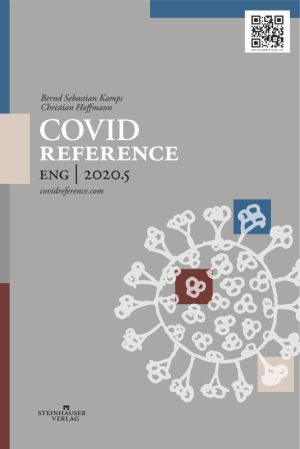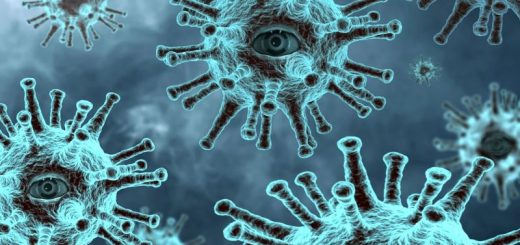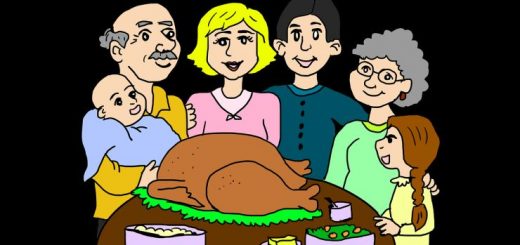++ The Textbook ++
| Treatment |
31 October 2020 | Let’s face reality: at the beginning of the second pandemic wave, we have some steroids which have been shown to reduce mortality in patients with severe COVID-19; and then we have a drug, remdesivir (Veklury®), which had a marginal benefit in a company-sponsored trial. That’s the COVID-19 treatment armamentarium as of October 2020.
Find the treatment chapter of the 5th edition at https://covidreference.com/treatment
Acalabrutinib – Anticomplement therapies – Azithromycin – Camostat – Chloroquine – Colchicine – Convalescent plasma – Corticosteroids – Cytokine blockers – Famotidine – Favipiravir – G-CSF – Human recombinant soluble ACE2 – Hydroxychloroquine – Ibrutinib – Iloprost – Interferons – JAK inhibitors – Leflunomide – Lopinavir – Monoclonal antibodies – N-acetylcysteine – Oseltamivir – (other) Protease inhibitors – (other) RdRp inhibitors – REGN-COV2 – Umifenovir
Thus, the next 35 pages will discuss many drugs that have shown so far NO effect. So why read this chapter? Because doctors need to know the state-of-the-art – even the ‘state-of-the-non-art’. Doctors must know why substances have shown NO effect and why there may still be new, innovative and creative ideas; why the senior physician has been less enthusiastic about tocilizumab over the last few weeks and why the 89-year-old diabetic on Ward 1 still gets remdesivir and famotidine; and why the plasma therapy did not work in the 51 yrs old obese woman who died on Ward 2.
Hopefully, within a few months, this chapter will contain only ten pages. We only need one good drug (or, for that matter, five me-too-drugs). Only one drug that must not even be perfect but could become a game changer in this pandemic (perhaps even more so and even sooner than a vaccine) because good enough to prevent people from becoming seriously ill. One drug to downgrade SARS-CoV-2 to the rank of their stupid seasonal common cold siblings nobody was really interested in during the last decades (except Christian Drosten).
Research activity is immense. A brief look at ClinicalTrials.gov illustrates the efforts that are underway: on April 18, the platform listed 657 studies, with 284 recruiting, among them 121 in Phase III randomized clinical trials (RCTs). On October 14, these numbers have increased to 3,598, 1,880 and 230. Unfortunately, many trials exclude those patients most in need: the elderly. A data query of ClinicalTrials.gov on June 8 revealed that 206/674 (31%) COVID-19 interventional trials had an upper age exclusion criterion. The median upper age exclusion was 75 years. Exclusion of older patients dramatically increases the risk of non-representative trial populations compared with their real-world counterparts (Abi Jaoude 2020).
Different therapeutic approaches are under evaluation: antiviral compounds that inhibit enzyme systems, those inhibiting the entry of SARS-CoV-2 into the cell and, finally, immune therapies, including convalescent plasma and monoclonal antibodies. Some immune modulators may enhance the immune system, others are supposed to reduce the cytokine storm and associated pulmonary damage that is seen in severe cases. In this chapter, we will discuss the most promising agents (those for which at least a bit of clinical data is available). We will not mention all compounds that may work in cell lines or that have been proposed from virtual screening models. We will also forget some.

Free Download: 5th Edition (Preview)
+ + +
| Transmission |
29 October 2020 | Almost a year after the first SARS-CoV-2 outbreak in China, the transmission dynamics driving the pandemic are coming into focus. It now appears that a high percentage (as high as 80%?) of secondary transmissions could be caused by a small fraction of infectious individuals (10 to 20%?); if this is the case, then the more people are grouped together, the higher the probability that a superspreader is part of the group.
5th edition: The chapter Transmission is now online:
Please share this chapter with your friends and colleagues.
+ + +
Fifth International Edition
| Preface |
Second waves, third waves, never ending waves – as the world is about to enter the second year of the SARS-Co
V-2 pandemic, people realize that they are just at the beginning of a global health and economic crisis. In the Northern Hemisphere, the 6 dark autumn and winter months have begun and the world is holding its breath: will the new corona virus follow the track of the 1918 flu epidemic, relatively mild in spring and devastating in autumn and winter?
There is no doubt that the immense resources of medicine and biotechnology will soon produce a safe and effective vaccine; however, only fools expect mass vaccinations before the middle of 2021 and a measurable impact on the pandemic before 2022.
In the meantime, people around the globe will reduce their contacts with other people and perfect their skills of social distancing. They will continue to wear face masks next year, the year after and maybe beyond. It isn’t fun but it must be done.
Bernd Sebastian Kamps & Christian Hoffmann
22 October 2020
Download the Preview PDF here (three chapters: Transmission, Prevention, The First 7 Months).




